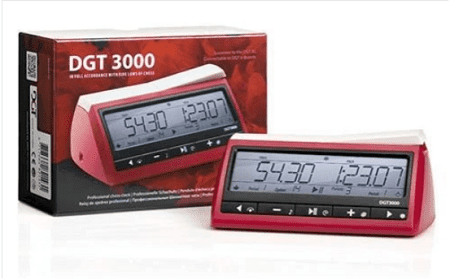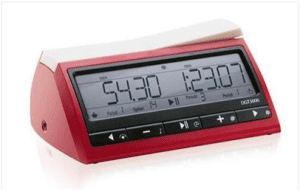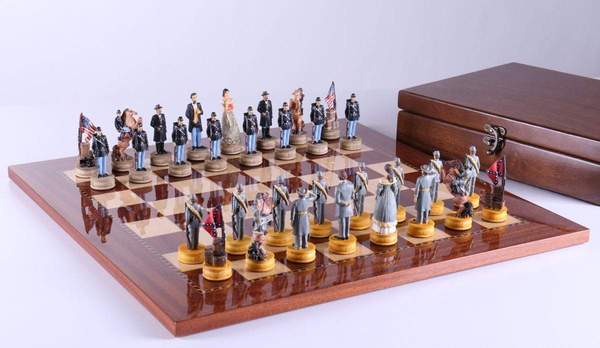The DGT 3000 chess clock is one of the most versatile timers for games with 2 players. The DGT 3000 has the ability to divide the thinking time between two players in any combination of known methods. The DGT 3000 can also be connected to the DGT e-Board.
Get The New DGT 3000 While In Stock!
With the connection, the timer can send the displayed times to a central tournament system, but it can also be used as a display to show the moves and times when a DGT e-Board is used to play against a computer or opponent over the internet. All timing methods that can be used with the DGT 3000 are described further in this article.
DGT 3000 Specifications
| Batteries | 2 AA (penlight) batteries. Alkaline batteries are recommended. |
| Power Usage | When the DGT 3000 is switched off, the batteries will last for approximately 5 years. It is recommended to replace the batteries sooner, though. In normal use, the batteries will last for about 10000 hours. When the clock is connected to a DGT e-Board, the batteries can power the clock for about 2000 hours. |
| Accuracy | Better than 1 second per hour. |
| Housing | ABS plastic |
| Display | 3.5 x 13 cm |
| Weight | 270 grams including 2 AA batteries |
Timing Methods
Many different mind games are played all over the world. All games have their own specific preference for different methods to divide the thinking time for the players.
In longer games, there are often time controls during the game. For example, players have to make a minimum of 40 moves in the first 2 hours, then 20 moves in the subsequent hour, and end the game within 15 minutes per player. The time between two-time controls is referred to as a period.
When one of the players runs out of time in a period that is not the last one, then the DGT 3000 will show a non-blinking flag at the side of that player. The time for the next period will then be added to both sides simultaneously. The players themselves or the arbiter have to check whether the required number of moves is played.
When a player at the end of the last period, or at the end of the only period, runs out of time, then the DGT 3000 shows a blinking flag at the side of this player. In some methods that are described in this article, the player who ran out of time can still finish his turn by pressing the lever at his side.
The time of the other player will then continue to count down. This player should claim his victory, but when he does not stop his time before it shows 0.00, the clock may show 0.00 on both sides. The blinking flag will indicate which player ran out of time first. The flag symbol originates from analog clocks. The big hand of these clocks lifts a small flag a short time before it reaches the top and then suddenly this flay will fall, indicating that all time is used up.
Time
The method in which the clock is simply counting down until one player reaches 0 is called TIME, “Guillotine” or “Sudden Death”. If there is only one time control, the player whose time reaches zero first has lost the game on time. In a game with more than one time control, a player must have played a required number of moves before each time control.
In some games, for example, in chess, it can be imagined that one of the players has an almost certain winning position in the end phase of a game. When this player has only a few seconds left, he will not have sufficient time to play the last winning moves or to finish the game with a draw. This player is likely to lose the game due to lack of time. An arbiter may declare the game to end in a draw if it is clear that the player who has run out of time had a winning position.
Thanks to the modern digital clocks there are now methods to finish a game with very little time left. The clock may pause a few seconds at the start of each turn, or the clock can add a certain amount of time after each move.
Fischer Bonus
This method was named after chess world champion Bobby Fischer: “Fischer Bonus” called FISCH in this article. In this method, a certain amount of time is added after each move. If players use less time per move than the set bonus time, then the time on the clock will be higher after the player has finished the move than at the start of the move.
The rules of the international Chess Federation (FIDE) stipulate that with this method the clock can no longer be operated after one of the players runs out of time in the last or only period. The clock “freezes” and a blinking flag will be shown. In this method, the FREEZE icon will be shown during the complete game in the upper part of the display.
US Delay
Another method to give the players extra time for each move is the delay method. The clock does not start to count down immediately when the player’s turn starts but will wait a few seconds before starting to count down. This method is mainly used in the United States of America and is therefore called “US-DELAY” (US-DLY).
Delay
Another method to achieve the same effect as US-delay is to add the delay time to the main time first. Then the clock starts to count down immediately. This method is called “Bronstein Delay” after chess grandmaster David Bronstein. When a player uses less time for a move than the set delay time, the time on the clock will be reset to the amount at the start of the move after the player finishes his turn.
When a player uses more time than the delay time for a certain move, then the delay time will be added to the remaining time on the clock at the end of the move. In this method, the total time can never be higher than what it was at the start of the move. An advantage of this method over the US-delay method is that the total time available is always displayed for each player.
A disadvantage is that the players cannot see whether or not they are still in their delay time. On the DGT 3000, this method is called DELAY. The final result of this method is exactly the same as in the US-delay method.
Byo-yomi
This method is also called Japanese Byo-yomi, but in this article, it will be referred to as BYO. This method is mostly used in games such as Go and Shogi. Byo-yomi is almost always preceded by a period TIME in which there is no required minimum number of moves.
Using this timing method, it is possible that player A is in his byo-yomi period while player B may still make several turns in the Time period.
In the byo-yomi period, each player gets a certain amount of time per move. If a player ends his turn within this time, the time on the clock will be reset to the value that it had at the start of the turn. If a player does not end his turn within this time, the DGT 3000 will show a non-blinking flag on the side of this player. The rules of the game determine if this player has lost the game, or is allowed to go on.
When the opponent ends his turn, the byo-yomi time will be reloaded, and the flag will disappear. The Japanese term “byo-yomi” means literately “counting the seconds.” In a byo-yomi period, the time is called out by an observer in intervals. The less time is left, the smaller these intervals become.
In most cases, during the last 10 seconds, the time will be called out every second.
A common setting in Go is 60 minutes TIME followed by 20 seconds byo-yomi. As mentioned previously, the byo-yomi period can start at different turns for each player. For example, the player with white can have 10 minutes left in the TIME period, while the player with Black already played several moves in the byo-yomi period.
In tournaments, the byo-yomi time is often divided into several periods. For example 5 periods of 1 minute each. If a player uses less time for a certain move than the byo-yomi time, he stays in the same period. When he needs more time for a move than the byo-yomi time, he will enter the next byo-yomi period.
When he runs out of time in the last period, the clock will show a non-blinking flag. The DGT 3000 always shows the total time a player has left. For instance, in a byo-yomi stage of 5 periods of 1 minute each, the clock will show 5 minutes.
When a player uses less time than the byo-yomi time on a certain turn, the time on the clock will be reset to the value at the start of the turn. (5 minutes in this example).
When a player in this example needs 1 to 2 minutes for a move, then the clock will jump to 4 minutes at the end of the move. He loses 1 byo-yomi period this way. In the same way, he may lose 2 periods in one move if he needs 2 to 3 minutes to complete one move.
Canadian Byo-yomi
The drawback of this method is that at the end of each period the time should be called out loud. In the era of analog timers, a certain number of moves were required in each byo-yomi period instead of just one move. When a player has played the required number of moves within this time frame, he will receive the same amount of time again for the next number of movers.
This sequence can be repeated many times. This method is called Canadian Byo-Yomi (CAN-BYO). When playing Go, it is common to get 5 minutes for 10 moves. Go players then place 10 stones aside that have to be played within these 5 minutes. When the 10th turn is played in time, the player again receives 5 minutes for the next 10 moves.
With this method, the players cannot save time by playing quicker than required. If the 10th move is played after, for example, 3 minutes, the time will be reset to 5 minutes.
On a DGT 3000, the player who has played the required amount of moves in time has to “reload” the time by pressing a button on the clock.
Upcount
Sometimes the time should count up instead of the usual count down. This is done for example, in Scrabble. After a TIME period of counting down, a count up period starts. The player whose side is counting up may lose a number of points per unit of time in the counting up phase.
Sound
In most methods, the sound is turned off by default, but it can be switched on and off at any moment by pressing the – / ♪ button for 3 seconds. When sound is switched on, a beep will be heard 10 seconds before all time is used up. In the last 5 seconds, a short beep will sound every second, and a long beep will be heard in the period between 0.01 and 0.00 seconds. The display will show the ♪ symbol in the upper central part when the sound is switched on.
How to operate the DGT 3000 chess clock
Descriptions of the Buttons
 |
|
 |
|
 |
|
 |
|
| ON/OFF
button |
|
First Use
When the DGT 3000 is switched on for the first time, it will show a blinking option number 01 and the settings for this option. Follow all steps that are described here for option 01 to become acquainted with the use of the DGT 3000.
If the clock was used previously, then it will show the last option number with the matching settings. The option number is blinking and can be accepted or changed immediately after switching the clock on.
Description of the preset methods
To become familiar with the use and settings of the DGT 3000, they are described here, with option 01 as an example. Switch on the timer and select Option 01 if necessary with the + or – button. By pressing the freeze button this option will be selected and the option number stops blinking. In the center of the display the pause/play icon will appear.
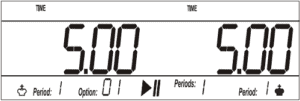
At this moment, the position of the lever determines which side of the clock will count down first. The side on which the lever is up will start first. This will be indicated with the white king icon at that side of the display. On the other side, the black king icon will be shown.
By default, FREEZE is turned off in this method, which means that the clock still can be operated after one of the players has run out of time. By pressing 3 seconds on the FREEZE button, this option can be set, or switched off by pressing this button again for 3 seconds. Once the clock has been started, the FREEZE option can no longer be changed
As soon as the central button is pressed, the time on the side where the white icon is shown, will start to count down. The pause symbol in the display will change into the run usymbol.
The sound can be switched on and off at any time by pressing the – / ♪ button for 3 seconds. By default the sound is off in this option. When the sound is on then the ♪ icon will be displayed in the top center part of the display.
Time correction
During a game, it may be necessary to make a correction of the time for one player or both players. This may be because a time penalty is required or because one of the players has violated a rule. There may also be other reasons, for example, if the clock was not operated correctly during the game.
To enter time correction mode, the clock should be in pause mode. This is achieved by shortly pressing the start/stop button. After pressing the same button again for 3 seconds, the DGT 3000 enters the correction mode. All digits will then be shown including any leading zeros. The digit on the far left side is blinking.

With the +or – button the value of the blinking digit can be changed. As soon as it has the desired value, you can select the next digit with the pause button. This digit starts blinking and can be changed. Continue doing this until all digits are set correctly. After accepting the far right (10th ) digit the display will change and display the number of moves.

If,at the time the clock was paused, it was in the turn of the player with White (the player who made the first move), then both players have completed the same amount of moves. If it was Blacks move, then White has played 1 move more than Black.
When you change the number of moves on the left side of the clock, the number of moves on the right side will change accordingly. It is possible though to change the number on the right side separately. This will result in swapping the positions of the white and black king icon. This may be necessary when the timer was started with the lever in the wrong position.
NB: Be very careful with this setting. If not carried out correctly it can result in an undesired situation.
In an option with only 1 time control, for example option 01, the DGT 3000 will return to the pause mode after the moves are set and accepted. The clock can then be started by pushing the start/stop button. In options with more than 1 period, the period number can be changed after the number of moves before the clock returns to the pause mode.
Changing the position of the lever in pause mode
Sometimes the lever position is changed during pause. This may be done on purpose, but sometimes it happens by accident. It may occur when the player who didn’t have the turn when the clock paused, should resume the game. When the lever position is changed during pause, there is no information if the lever was switched too soon, or that one of the players forgot to push the lever.
When the DGT 3000 is started after a pause and the lever was switched during this pause, then it will automatically go to the correction mode. The players or the arbiter can then set the number of moves, and if necessary change the time. When the lever is switched in the correction mode, then the number of moves will change on the right side of the clock. It may then be necessary to correct the number of moves at the left side.
Computer/ Internet Use
This option should be used when the DGT 3000 is connected to a DGT e-Board. The clock will serve as a display for a computer chess program. The lever and all buttons are disabled. When this option is selected, the clock will start with a display like this:

When a game is on, the display will show the moves and the time that the computer sends to the clock. For example if the opponent played Qd1xNg4 it will show this:

When there is a connection with a computer the equivalent symbol will be shown in the top of the display.
Special Settings
Armageddon
In Chess tournaments sometimes a decision should be forced after a tie. Then the so called “Armageddon” method can be used. In this method White receives more time then Black, but Black is the winner if the game ends in a draw.
For example, White gets 5 minutes and Black 4 minutes. Mostly a bonus or delay of 3 seconds is used after the 60th move. The DGT 3000 does not however allow starting a next period after a number of moves in a TIME method though in a period with the FISCH method this is possible.
The solution to set an Armageddon timing system is to start with a FISCH period with 0 seconds bonus. Then enter 60 as the number of moves. In the second period the main time is set to 0:00.00 and the Bonus time is 0.03. Select END after this. It is also possible to use DELAY or US-DELAY in the second period.
Move-timer
In some games players receive only a certain fixed time per move, which is reloaded after each move. When a player reaches 0.00 it must be possible to continue play. This is called a move timer. With the DGT 3000 move timer can be set with a byo-yomi (BYO) method as first period. The byo-yomi time should be set to the time per move and the number of periods to 00.
Period transitions with different bonus or delay times
The DGT 3000 makes it possible to program subsequent periods with different bonus or delay times. The World Chess Federation FIDE requires that in a Fischer bonus period the bonus time must be added for the first move. So it should also be added for the first move of every subsequent period.
This is important when the bonus time changes in the next period. A common setting is that a period of Time (no bonus per move) is followed by a Fischer period with a certain bonus time per move. As soon as the Fischer period starts, then the bonus time should be added together with the main time for the next period.
In general: when a new period is started because one of the players reaches zero, the main time for the next period is added plus the difference between the new and the old time per move. When the player with the Black figures reaches 0.00 first, then the time for White has to be corrected with the difference between the new and old time per move, because White received the old time per move before the next period started.
Batteries
The DGT 3000 works with two AA (penlight) batteries. These batteries are included with the clock in the box. When these batteries are exhausted it is recommended to exchange them for alkaline batteries. We recommend removing the batteries if the clock will not be used for a longer period in order to avoid damage that can be caused by leaking batteries.
When you see a low battery icon symbol in the top of the display the batteries should be exchanged although the clock can still be used for several long games.
Exchanging the batteries
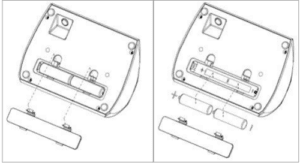
- Remove the battery cover.
- Remove the used batteries.
- Place new batteries in the compartment with the + pole as indicated.
- Replace the battery cover.
- Dispose of your old batteries in a proper way.
Non rechargeable batteries should not be recharged; do not use rechargeable batteries; do not use new and used batteries together; place the batteries with the proper polarity in the battery compartment; exhausted batteries should be removed from the product; never short circuit the terminals of batteries.
Warranty conditions
DGT guarantees that the digital chess clock complies with the highest quality standards. If your DGT 3000, despite our care in choosing components, materials, production and transport, nevertheless shows a defect during the first five years after purchase, you should contact the retailer where you obtained the product.
You may be asked to present a proof of purchase. When a problem occurs give detailed description of the fault and the serial number of the clock. The warranty is only valid if the DGT 3000 has been used in a reasonable and prudent manner as it is intended to be used.
This warranty shall not apply if the clock has been misused or if any unauthorized repair attempts have been undertaken without express written consent from the manufacturer.
Conclusion
The DGT 3000 is a durable, well-made product. It’s known to be one of the best chess clocks on the market due to its longevity, efficiency and ease of use. If you treat it with reasonable care it should give you years of trouble-free performance. To clean the clock, use only a slightly moistened soft cloth and do not use abrasive cleansers.
So what are you waiting for? Get the New DGT 3000 chess clock while stocks last!
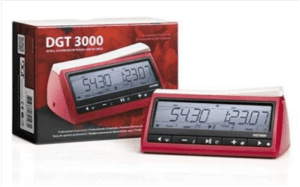
Get the New DGT 3000 Chess Clock
Related Post: Time control for chess tournament
